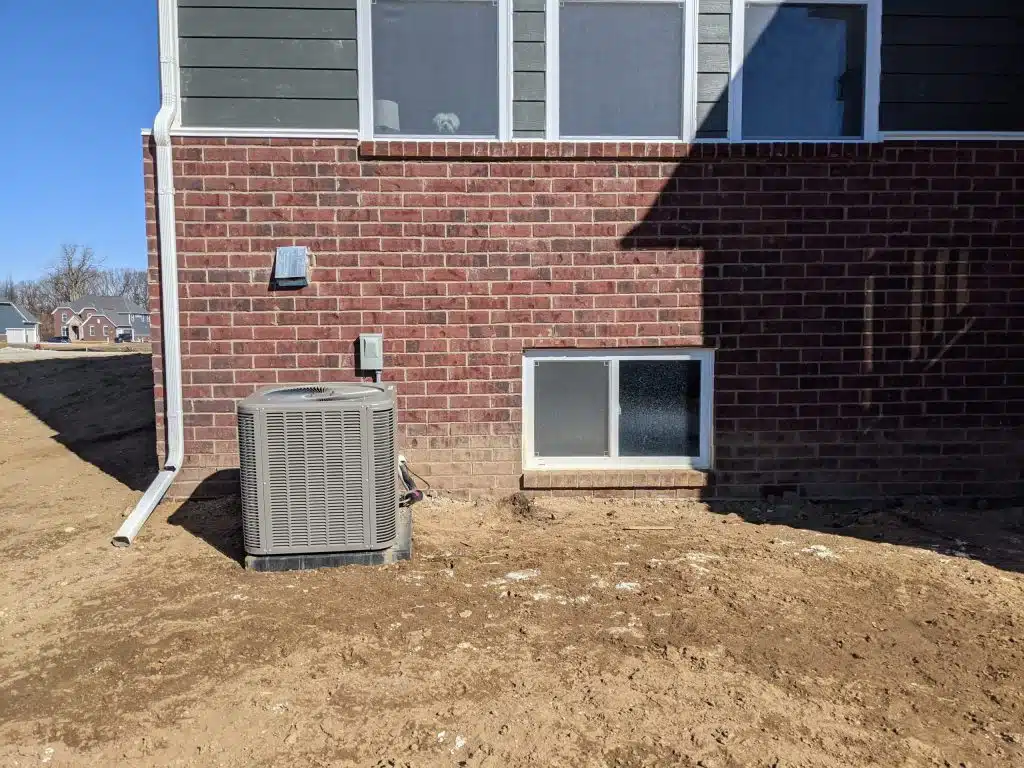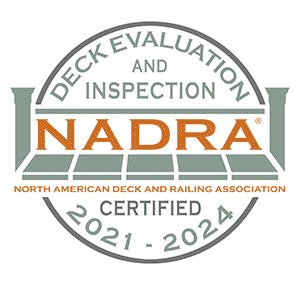Homebuilders love to create little obstacles for us deck builders. Everything from AC units, gas meters, dryer vents, sump pumps, water spigots, and so on…
Of course, we understand they all serve a purpose. Fortunately, any difficulties they create during a deck design or build are usually quick and easy to solve.
Today, we’ll cover the guidelines for building around these obstacles, their space requirements, and alternatively, how much it can cost to move them (if desired).
Building a Deck Over an AC Unit
Building your deck over top of an AC unit is entirely possible and quite common. The catch is you must leave enough space for the compressor to work efficiently and have easy access to the system for any maintenance or unit replacement purposes.
How Much Clearance Do You Need Above Air Conditioning?
You’ll find that most air conditioner manufacturers recommend at least 5 feet of clearance above the top of the compressor. This space allows the warm air to freely exhaust away from the unit. If you build lower than that, it can restrict proper airflow and cause the system to overheat or break down. The warm air can also promote mold growth on the bottom of the decking boards above.
Additionally, you’ll want to leave enough space around the AC unit for possible maintenance/replacing and for circulation. Typically, leaving a few inches or a foot will be sufficient for proper air circulation.
How Much Does It Cost to Move an AC Unit?
Alternatively, a qualified plumber can also move your AC if that’s the route you decide to take.
The cost varies based on how far you want to move the unit, the difficulty of the move, and of course where you live. But typically, the price will range from around $1,000 and $2,000.
Building Around the AC Unit
Most commonly, and what we’d recommend, is to work with your deck builder and design a deck that works around the AC unit. Doing this ensures the system will run efficiently as possible, help extend its overall lifespan and save you the extra cost of moving it.
Building a Deck Around Vents
Building around vents is something most deck builders (including ourselves) do every day; vents such as:
- Dryer vents
- Fresh air intake vents
- Bathroom fan vents
- Crawl space vents
They’re usually easy to frame around, but if the vent is active, you don’t want anything to obstruct it completely (after all, it’s a vent for a reason!). This advice is especially important for gas dryer vents because they expel CO2.
If you’re unsure if the vent is active or not, try tracing it back to the source (i.e. a bathroom, a dryer, etc.).
Outside Access
Keep in mind that dryer vents also need easy access from the outside. That way you’ll be able to clean the ducts semi-regularly to limit lint buildup, which in turn prevents blockages and dryer fires.
Consider the height of the vent to how high you’d like your deck. If the top of the vent is level or just below your deck, it’ll be easy enough to frame around. If the top of the vent is above the desired height of the deck, you have a few options:
Frame
The most common approach is to simply frame around the vent and leave a small portion of it visible from the top of the finished deck. You can then place a piece of furniture or a grill in front of it to make it less visible.
Build a Box
Another solution we’ve done is to build a box around the vent to conceal it. While the vent won’t be visible, you’ll have a larger object you may want to hide to keep the space aesthetically pleasing.
Move the Vent
Sometimes (but not always), you can hire a professional to move the vent. This is rarely necessary for a deck build, but it certainly has come up a handful of times. The level of difficulty and investment of moving a vent depends on several factors such as:
- The type of vent
- If you have a finished basement
- What obstructions might be in the way
- The material of the wall surrounding the vent
If your exterior wall is siding, it’s usually a relatively easy process. However, if it’s brick, you’ll need to install additional brick and grout, which can add to the total price.
Because the costs vary so much, we can’t give you an accurate idea of pricing. We recommend contacting a local specialist (usually an HVAC company) for quotes if it’s an option you’re considering.
Building Over Electrical and Gas Meters
Usually, electrical and gas meters aren’t too big of an issue when designing and building a deck. But they do need to be readily accessible, so anyone can easily walk up and access them.
The main reason for this is in case of an emergency, such as a building fire. Firefighters will need to quickly access the meters to turn off the electricity and gas to the house.
Electrical and Gas Meter Clearance Code
Code states that you can’t build a permanent structure (such as a deck) in front of these meters. There needs to be at least 6 feet of headspace or height clearance in front of them. Plus, a clear walking path that’s at least 3 feet wide.
The Cost to Move a Meter
The cost to move a meter can vary wildly in price. It’s usually about $2,000 to $4,000, but it can end up being more. The process involves hiring a local licensed contractor but also working with your electrical or gas service provider.
Hire a Pro
Building a deck around AC units, meters, or vents is usually not a problem. But if you want to avoid issues down the road, the installation must be done with extra care.
Talk with your local deck builder about working around these common obstacles. Or, if you live in Southeast Michigan, feel free to get in touch with us.
At Custom Deck Creations, we can help you design and build a composite deck around any obstacles, and we’ll be honest if we think something is better off being moved.
If you’d like to see our most recent work, please visit our gallery! Or for more information on building decks, you can check out our learning center.









